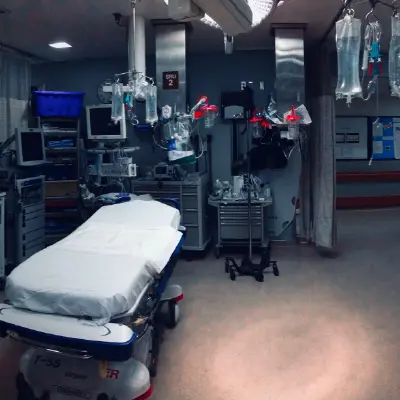
TamingtheSRU
94 episodes Last Updated: Jun 25, 25
www.tamingthesru.com - Free. Open-Access. Focused on Emergency Medicine, critical care and prehospital medicine, as well as practice algorithms and decreasing knowledge translation in Med Ed.
Episodes
Lung-protective ventilation (LPV), characterized by low tidal volumes and appropriate PEEP, is a cornerstone in managing patients with acute respiratory distress syndrome (ARDS). However, its application in patients with severe acute brain injury raises concerns. The potential for lung protective ventilation to increase intracranial pressure due to hypercapnia and elevated PEEP levels necessitates a closer examination of its safety and efficacy in this unique patient population.
Jun 18, 2025
Is Old Age a Reason to Scan a Cervical Spine?
Many clinical decision rules exclude elderly patients from the derivation cohorts. So the question remains unanswered do all elderly patients need cervical spine CTs in the setting of trauma? What if they have no symptoms? This recap of a journal club article explores the incidence of significant cervical spine fractures in elderly patients.
Jun 11, 2025
Using Sound Waves to Help a Cric
It is well known that ultrasound has exploded in its application in both diagnostics and procedures and has ultimately revolutionized the way we practice medicine. With its growing use, more and more providers are comfortable using ultrasound for both identification of anatomy/pathology and to guide procedures that were previously only done with landmarks. While having the skills to perform landmark guided procedures is incredibly important, there is much value in being able to visually confirm anatomy to avoid procedure complications, especially when landmarks are difficult to palpate / identify in certain individuals. This recap of a recent journal club article covers a paper looking into the use of POCUS to help perform cricothyrotomy.
May 27, 2025
NIPPV vs OM for preox
More than 1.5 million critically ill adults undergo tracheal intubation each year in the United States. Hypoxemia is a common and serious complication during tracheal intubation in critically ill adults, occurring up to 10-20% of intubations in the emergency department (ED) or intensive care unit (ICU). Hypoxemia increases the risk of cardiac arrest and death. The effect of preoxygenation with noninvasive ventilation, as compared with preoxygenation with an oxygen mask, on the incidence of hypoxemia during tracheal intubation is uncertain. In this breakdown of a Journal Club article, Dr de Castro will cover a recent paper comparing NIPPV to oxygen mask only during preoxygenation for intubation.
May 07, 2025
Is Hyperoxemia in Trauma Bad?
Severe trauma is the leading cause of death worldwide for adults younger than 50 years of age. Acute traumatic life support (ATLS) guidelines endorse early and aggressive usage of supplemental oxygen in patients with severe trauma, at least until abnormalities of airway or breathing can be safely ruled out. However, unclear target concentration, duration or saturation goals often leads to hyperoxemia. Emerging studies in the intensive care unit (ICU) setting suggest that liberal supplemental oxygen therapy and hyperoxemia is associated with increased mortality. Limited evidence in the trauma population suggests similar outcomes.
We know that the d-dimer can be a helpful test for patients who have a low pre-test probability of pulmonary embolism. But can the test be pushed into use for higher risk patients? Will it still have useful negative predictive value or will we risk missing too many PEs?
Apr 10, 2025
Oral Nitro for Food Bolus Impaction
Can a nitro slurry help with food bolus impaction? Glucagon and effervescent beverages have limited evidence for benefit. Can an old drug used in a new way help these patients?
Oct 31, 2024
Pediatric Septic Score
Current screening tools for pediatric septic shock and sepsis are highly specific but lack sensitivity. This study substituted age adjusted vital sign measures and a pediatric shock index into currently existing pediatric sepsis scoring systems to create the qPS4.When utilizing a cut off of ≧ 2 points, the qPS4 was highly sensitive and specific, and identified pediatric septic shock far sooner into a patient's course.
There is a wide variation in practice, particularly in obtaining neuro-imaging in patients presenting with vertigo. Many patients are imaged and subjected to a longer length of stay, and on the other side of the coin, some patients with serious pathology fall through the cracks. The authors of this study set out to create a risk score to apply to patients who present to the ED with vertigo which would identify the patients at risk for serious pathology (which they defined as stroke, TIA, vertebral artery dissection, or brain tumor).
Jul 24, 2024
Sniffing out Sepsis - Vibes vs Scoring Systems?
Sepsis remains an increasingly common emergency department condition that is tied to higher morbidity and mortality across the United States as well as the rest of the world. Sepsis as a disease process has been difficult to both clearly define and quickly recognize. Many metrics for recognition and management of sepsis are dependent upon various scoring systems, including SIRS, SOFA, qSOFA, and MEWS, none of which were designed for the acute detection of sepsis within the emergency department. This journal club recap will look at an article by Knack et al looking at physician gestalt vs scoring systems for the detection of sepsis.